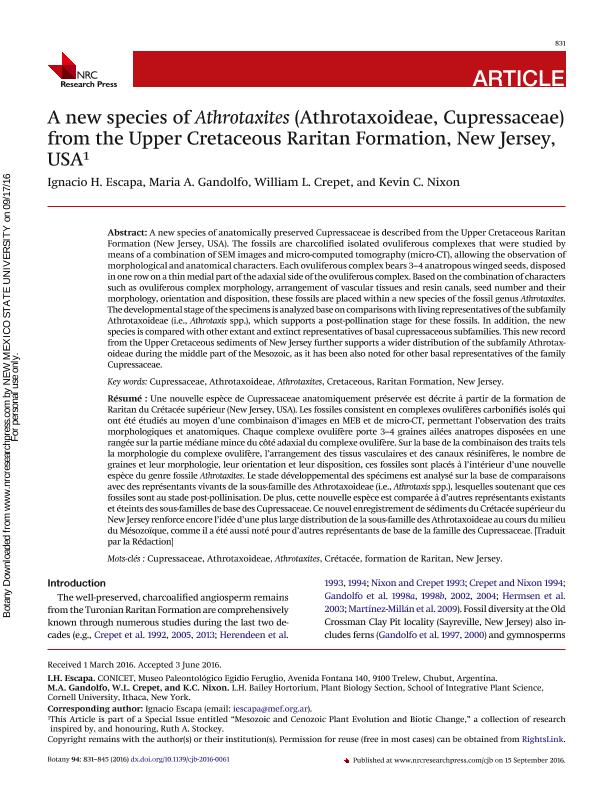Artículo
A new species of Athrotaxites (Athrotaxoideae, cupressaceae) from the upper cretaceous raritan formation, New Jersey, USA
Fecha de publicación:
09/2016
Editorial:
Canadian Science Publishing
Revista:
Botany
ISSN:
1916-2804
Idioma:
Inglés
Tipo de recurso:
Artículo publicado
Clasificación temática:
Resumen
A new species of anatomically preserved Cupressaceae is described from the Upper Cretaceous Raritan Formation (New Jersey, USA). The fossils are charcolified isolated ovuliferous complexes that were studied by means of a combination of SEM images and micro-computed tomography (micro-CT), allowing the observation of morphological and anatomical characters. Each ovuliferous complex bears 3-4 anatropous winged seeds, disposed in one row on a thin medial part of the adaxial side of the ovuliferous complex. Based on the combination of characters such as ovuliferous complex morphology, arrangement of vascular tissues and resin canals, seed number and their morphology, orientation and disposition, these fossils are placed within a new species of the fossil genus Athrotaxites. The developmental stage of the specimens is analyzed base on comparisons with living representatives of the subfamily Athrotaxoideae (i.e., Athrotaxis spp.), which supports a post-pollination stage for these fossils. In addition, the new species is compared with other extant and extinct representatives of basal cupressaceous subfamilies. This new record from the Upper Cretaceous sediments of New Jersey further supports a wider distribution of the subfamily Athrotaxoideae during the middle part of the Mesozoic, as it has been also noted for other basal representatives of the family Cupressaceae.
Archivos asociados
Licencia
Identificadores
Colecciones
Articulos(SEDE CENTRAL)
Articulos de SEDE CENTRAL
Articulos de SEDE CENTRAL
Citación
Escapa, Ignacio Hernán; Gandolfo, Maria A.; Crepet, William L.; Nixon, Kevin Clark; A new species of Athrotaxites (Athrotaxoideae, cupressaceae) from the upper cretaceous raritan formation, New Jersey, USA; Canadian Science Publishing; Botany; 94; 9; 9-2016; 831-845
Compartir
Altmétricas




